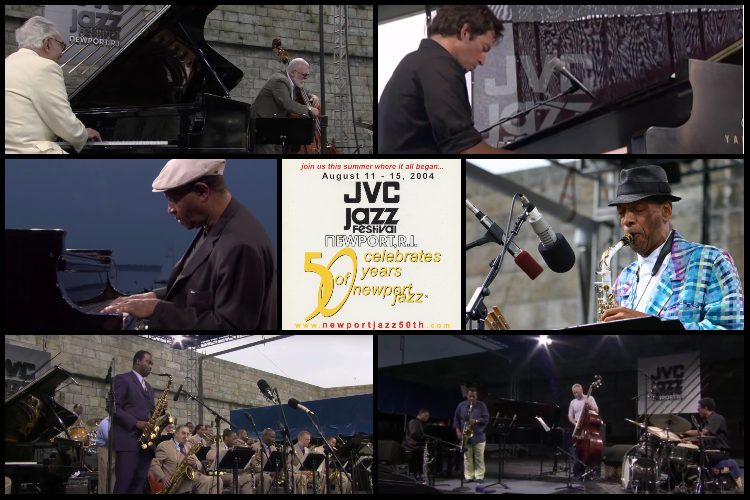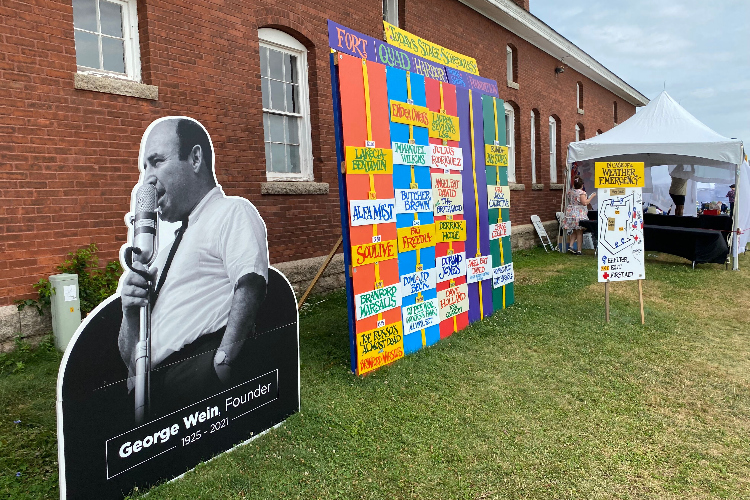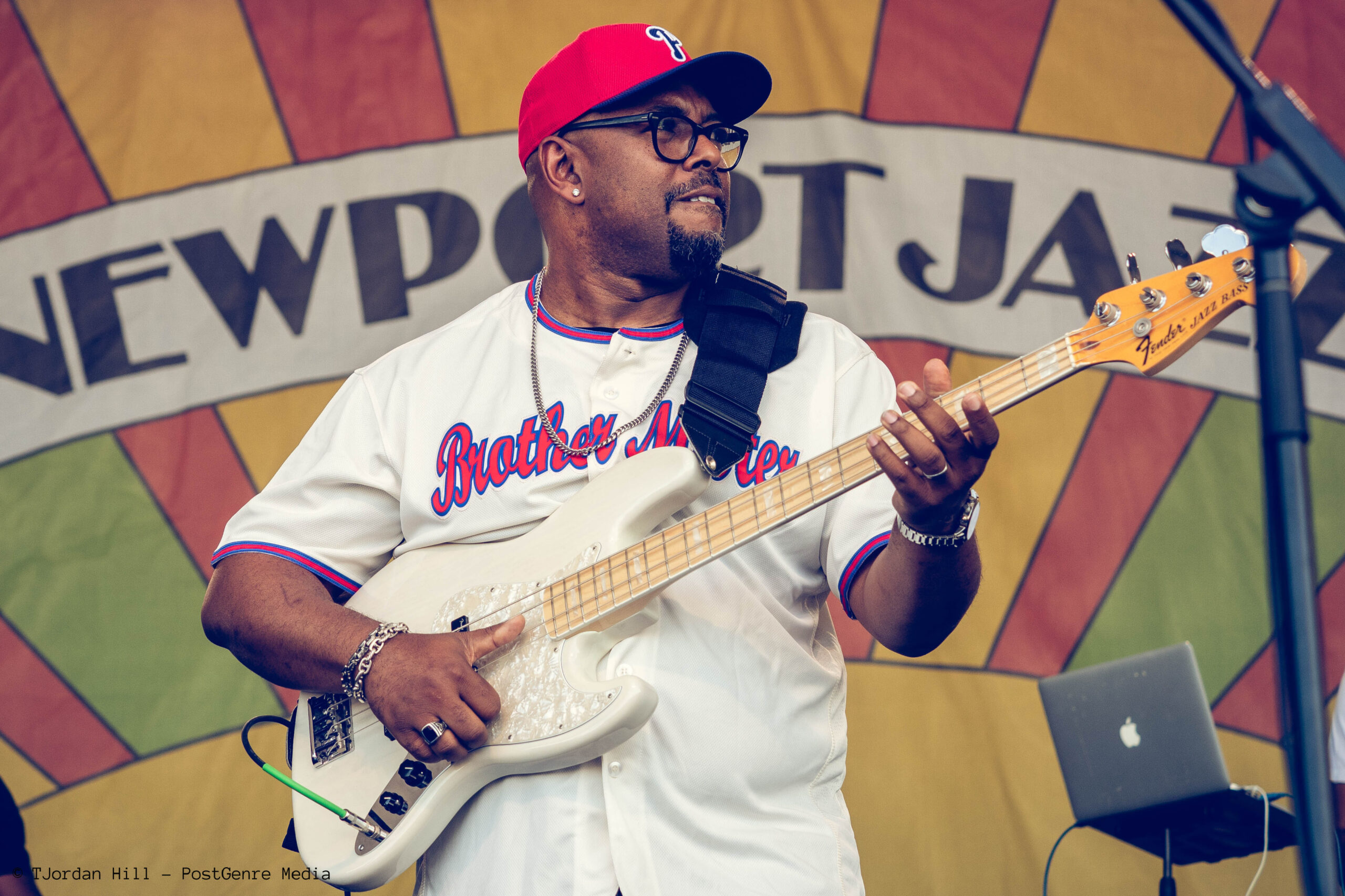A History of the Newport Jazz Festival – Chapter XIII: Echoes of the Past, 2004
|
Getting your Trinity Audio player ready...
|
An intense and unceasing downpour left a twenty-eight-year-old George Wein with the difficult question of whether to abruptly cancel his new jazz festival. In response, he adopted a “rain or shine” policy which refused to stop the music. This mindset served the Newport Jazz Festival well over the years. The special 50th-anniversary edition was itself conducted under gray or precipitous skies for almost the entire weekend. Some things never change.
And yet, others do. For the first time in the half a century since its birth, the event would be without the physical presence of its almost octogenarian founder. Wein would miss the celebration, sans a Thursday night gala at the Breakers, to recover at his New York home from a recent intestinal surgery. But even in his absence, he remained intricately involved in the proceedings, not only planning in the preceding months but by telephone to his team behind the scenes each day of performances. His wife Joyce, who had played a central role in the Festival Productions Empire since the 1950s, also helped ensure things continued as planned. But Wein’s disappearance was felt by many; several artists dedicated their sets to him. Perhaps fittingly given Wein’s own instrument of choice, the piano also played a major role at that summer’s festival.
Festivities started on the evening of Wednesday, August 11th, with a special performance at the local Rogers High School by Dave Brubeck. Since his first appearance at Newport in 1955 – before Time Out (Columbia, 1959) made him a household name – Brubeck had appeared at the event 32 times, more than any other artist. He was also an advocate of integration and racial justice. Throughout the 1950s and 1960s, Brubeck refused to perform without bassist Eugene Wright despite pressure from various concert promoters to do so on account of the fact Wright was Black. Brubeck also addressed racial justice issues in some of his projects, most notably “The Gates of Justice” (1969). The piece originated in 1968 when the Union of American Hebrew Congregations approached Brubeck seeking a musical work to help unite Jewish and Black communities. Being neither Black nor Jewish, the pianist was hesitant at first but accepted the commission. The result was an almost hour-long cantata based on Judaic texts, biblical verses, and excerpts from speeches by Dr. Martin Luther King, Jr. In juxtaposing these sources, he hoped to expose parallels between the prophet Isaiah’s and Dr. King’s dreams of a better society. In commemoration of the 40th anniversary of the Civil Rights Act of 1964, Brubeck re-recorded Gates and presented its updated version at Newport.
For those looking for music more akin to that which made Brubeck so well known, an opportunity was provided at Fort Adams on Saturday, August 14, when he appeared with his quartet of bassist Randy Jones, drummer Bobby Militello, and woodwind player Michael Moore. Together they played lively renditions of several songs, including the Paul Desmond tune most associated with their bandleader, “Take Five.”
Dave Brubeck was not the only bandleader to perform across multiple days. On Friday, August 13, Harry Connick, Jr. brought his big band to the Newport Casino and Tennis Hall of Fame – the site of the first Newport Jazz Festival. The ensemble relied primarily on its leader’s skills as a vocalist as they performed 1950s and 1960s ballads in support of this recent release, Only You (Columbia, 2004).
The next afternoon found Connick at the Fort emphasizing his skills on the keys fronting a quartet with bassist Neal Caine, saxophonist Charles “Ned” Goold, and drummer Arthur Latin. Presenting an entirely instrumental set reminded audiences that while Connick received more attention for his vocal works, he was still the same person who studied with New Orleans legends, James Booker and Ellis Marsalis.
This second set took place not on the main platform but a smaller one – the former Harbor Stage, now dubbed the Dunkin’ Donuts stage – a testament to the success of the decision a few years earlier to expand the offerings at the Fort. A third was also added in 2004, parallel to the Harbor stage and close to the water. This small tent, sponsored by Sirius Satellite Radio, provided a performance space dedicated to solely one instrument, in this case, the piano. Saturday brought an afternoon hosted by Marian McPartland featuring Kenny Drew, Peter Martin, Mulgrew Miller, Renee Rosnes, and Hilton Ruiz. For Sunday, it was a duet of Geri Allen and Wallace Roney, followed by Uri Caine, Bill Charlap, and Jason Moran.
To celebrate the Festival’s anniversary, sets were dedicated to giants of the past. Some of the greatest moments at that summer’s festival were performances dedicated to figures no longer with us.
On Saturday, pianist Barry Harris presented a quartet dedicated to the music of his hero Thelonious Monk. The performance reminded audience members of not only the great influence Monk had on future artists, but also provided a beautiful send-up to a man whose composition ‘Round Midnight kick-started Miles Davis’ career at the 1955 Festival and who temporarily left retirement to perform at the 1975 Festival in New York.
John Coltrane Remembered reunited the surviving members of the saxophonist’s quartet that first appeared at the Newport Jazz Festival, McCoy Tyner and Roy Haynes. Although Elvin Jones was Trane’s regular drummer during that era, Haynes regularly stepped in when the group was on tour, including their stop at Newport. In a sad bit of irony, Jones died only a few months before this performance. Rounding out the rest of the group were two saxophonists – it would have been impossible to fill his shoes with just one – his son Ravi Coltrane and Michael Brecker. And, on bass, Christian McBride. The group’s extended improvisations on the beautiful compositions of their honoree emphasized not only the majesty of the originals but how they have been used to propel music forward more generally.
The Jon Faddis Jazz Orchestra – featuring guests Ron Carter, Jackie McClean, James Moody, Ken Peplowski, Clark Terry, and Phil Woods – explored the music of four additionally iconic artists. In so doing, the band underscored the event’s historical significance. The band hinted at the once-in-a-lifetime Carnegie Hall reunion in 1973 of Benny Goodman, Lionel Hampton, Gene Krupa, and Teddy Wilson with selections from the clarinetist’s songbook. Audiences were reminded of an incredible performance at Freebody Park in 1957 with Count Basie’s compositions. Dizzy Gillespie, who was a mainstay at the Festival over the decades, was visited as well. The final artist, Charlie Parker, never actually performed at Newport as he died at the young age of 34 in 1955. However, his influence on those who had and on music, in general, was undeniable.
On Sunday, another large ensemble, The Lincoln Center Jazz Orchestra, leaned even further into providing intergenerational collaborations in memory of artists passed, namely Ellington, Monk, and Armstrong. This shouldn’t be too surprising given the avid interest in jazz history of the group’s leader, Wynton Marsalis. The trumpeter, however, proved unable to attend as he was recovering from a lip injury. Nicholas Payton took his place on the horn. While the pieces were focused on three artists, Duke, in particular, rose above. Clark Terry, who had appeared with Ellington’s Orchestra several times over the years, including the landmark 1956 performance, joined in for two numbers, albeit Satchmo pieces. Gary Burton, who missed out on his first performance at Newport at age 17 due to the 1960 riot, appeared with his young teenage student Julian Lage for a subdued “Black, Brown and Beige.” Regina Carter – who also performed that day with her own quartet – brought her virtuosic playing to “Come Sunday,” equally a tribute to Ellington as to the great Mahalia Jackson who sang it with him. But the best moment was saved for last when the Orchestra acknowledged Ellington’s 1956 performance with a rousing revisit of “Diminuendo and Crescendo in Blue.” The energetic 27 chorus solo by Paul Gonsalves, which jumpstarted the bandleader’s career, was given a modern analogue in an even longer one by James Carter.
Elsewhere during the weekend, Chico Hamilton reprised a drum solo he first performed at the 1958 Festival and which was captured on Jazz in a Summer’s Day. Art Blakey, who first appeared at Newport in 1956, was honored by a version of the Jazz Messengers featuring Cedar Walton, Roy Hargrove, Donald Harrison, Lewis Nash, Steve Turre, Peter Washington, and Bobby Watson. Lee Konitz, who performed at the first Newport Jazz Festival back in 1954, shared the music of his trio with Billy Drummond and Drew Gress. The young Japanese pianist, Toshiko Akiyoshi who impressed listeners in 1956 was now fronting a trio augmented by her husband, saxophonist Lew Tabackin. Percy Heath, who performed with Miles Davis in his memorable 1955 set joined his brothers Jimmy and Tootie.
Subtle nods were also made to the 1960 Rebel Festival on Sunday. Bass heavyweight Charles Mingus was represented by his still thriving Big Band featuring Ronnie Cuber, Kenny Drew, Donald Edwards, Wayne Escoffery, Eddie Henderson, Conrad Herwig, Boris Kozlov, Earl McIntyre, Jeremy Pelt, Kenny Rampton, and Jaleel Shaw. Somewhat similarly, the groundbreaking Ornette Coleman appeared in Newport proper for the first time since 1972 at Festival Field. With sidemen Greg Cohen and Tony Falanga on bass and his son, Denardo, on drums, the harmolodic innovator continually switched between his saxophone, violin, and trumpet in trying to find a middle ground between complex classical composition and jazz. Unfortunately, it is unclear if any recordings exist of this performance. However, the music was generally beginning to tread towards the ideas which would ultimately win him a Pulitzer Prize in Music a few years later.
The “New Thing” which shocked audiences during the 1965 Festival found two of its spokespersons – Roswell Rudd and Barry Altschul – joining Dave Douglas at the 2004 Festival. Although Douglas had previously performed at Newport with John Zorn’s Masada, Vacation Blues marked his first performance there as a leader. The band examined the space between traditional Dixieland and the avant-garde.
As was always the case throughout Newport’s history, however, focus was not left solely on the past. In addition to the Regina Carter set, Ravi Coltrane, Dianne Reeves, and Branford Marsalis’ Quartet with special guest Miguel Zenon all had their moments. So did pianist-signers Jamie Cullum and Peter Cincotti and guitarist Doug Wamble.
Perhaps further underscoring the importance of supporting the next generation of artists was the event’s treatment of Miles Davis. There were no sets specifically dedicated to his music or his moments at Newport. And yet, he remained present. In large part, this was because those who learned from him ingrained their teachings into their own ideas and sounds. Ron Carter’s trio with Russell Malone and Mulgrew Miller took a more traditional approach to music. The bassist – who first appeared at Newport with Miles in 1965 – gave credence with a luscious version of “My Funny Valentine,” harkening to the trumpeter’s reputation as a gentle caresser of notes. Carter’s former bandmates, Herbie Hancock and Wayne Shorter accented different lessons from the master; on how to continually evolve. Their more experimental Sunday closing set was built primarily off of compositions the two penned for 1+1 (Verve, 1997). But, like Miles approaching a standard, the songs were stretched and twisted to present new scenes. The addition of fellow Davis alum Dave Holland and drum phenom Brian Blade made these contortions all the more possible and produced beautiful results.
As the Newport Jazz Festival ended its fiftieth year, it was clear that the event’s amazing backstory was neither forgotten nor overlooked. At the same time, however, it was not mired in the past. Instead, the brilliance of artists who came before echoed and reverberated to those of today. A celebration of the Newport Jazz Festival’s half-century milestone was as much a commemoration of the event that started it all as one of those who made it possible along the way. In terms of artistry, this means not just the musicians who made history but also those who stand upon their shoulders and who will, someday, be giants themselves.
The 2021 Edition of the Newport Jazz Festival will take place from July 30th to August 1st at Fort Adams State Park. We plan to have live coverage of the event. More information can be found on the Festival’s website.



